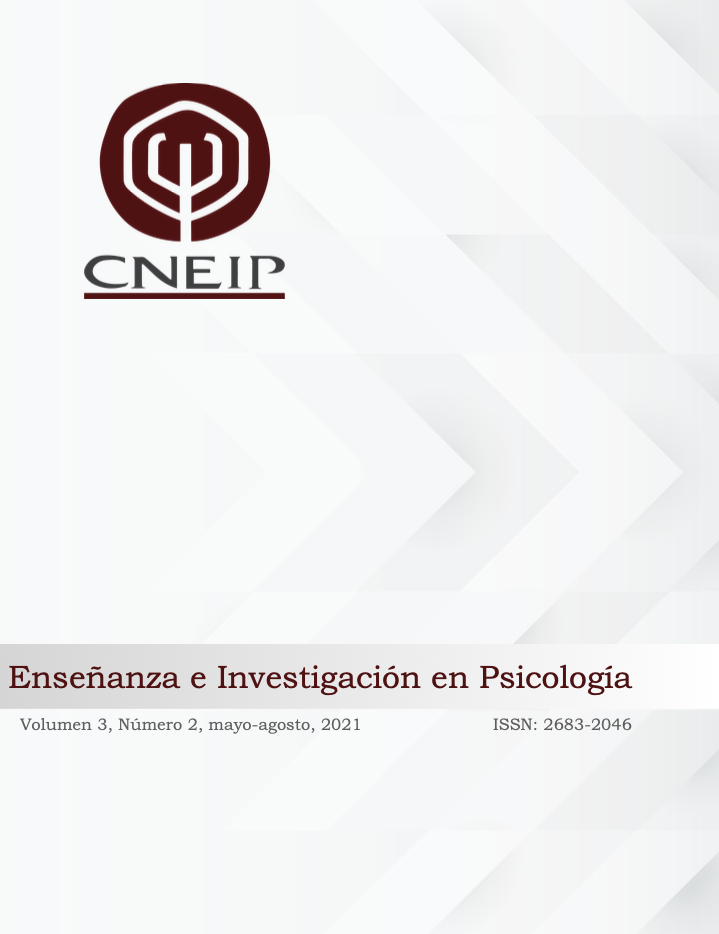Resumen
En la presente investigación se buscó probar, en una clínica universitaria especializada en atención psicológica a trabajadores, el efecto de un modelo sistemático de tratamiento para trastornos del estado de ánimo y la promoción del bienestar humano. La muestra estuvo conformada por 107 participantes: 63 mujeres y 44 hombres con una media de edad igual a cuarenta años. El modelo se basa en la detección, orientación y referencia a tratamiento, esta intervención tuvo una duración de ocho sesiones con un modelo pre-experimental para dos muestras relacionadas, y los resultados se calcularon a través de una prueba T de Student para muestras relacionadas. Los resultados arrojaron diferencias estadísticamente significativas entre la evaluación pre-test y post-test, encontrando una reducción en la sintomatología depresiva, ansiosa y el malestar psicológico en general.
Referencias
Agerwala, S. M. y McCance-Katz, E. F. (2012). Integrating Screening, Brief Intervention, and Referral to Treatment (SBIRT) into Clinical Practice Settings: A Brief Review. Journal of Psychoactive Drugs, 44(4), 307-317 https://doi.org/10.1080/02791072.2012.720169
Borges, G., Medina-Mora, M., Wang, P., Lara, C., Berglund, P. y Walters, E. (2006). Treatment and Adequacy of Treatment of Mental Disorders Among Respondents to the Mexico National Comorbidity Survey. Am J Psychiatry, 163(8), 1371-1378. https://doi.org/10.1176/ ajp.2006.163.8.1371.
Foss-Kelly, L., Generali, M. y Kress, V. (2017). Counseling strategies for empowering people living in poverty: The I-CARE model. Journal of Multicultural Counseling and Development, 45(3), 201–213. https://doi.org/10.1002/jmcd.12074
Hargraves, D., White, C., Frederick, R., Cinibulk, M., Peters, M., Young, A. y Elder, N. (2017). Implementing SBIRT (Screening, Brief Intervention and Referral to Treatment) in primary care: lessons learned from a multipractice evaluation. Public Health Reviews, 38(31), 2-11. https://doi.org/10.1186/s40985-017-0077-0
Kroenke, K., Spitzer, R. L. y Williams, J. B. (2001). The PHQ-9. Validity of a Brief Depression Severity Measure. J Gen Intern Med, 16(9), 606-613. https://doi.org/ 10.1046/ j.1525-1497.2001.016009606.x.
López Huerta, J., González R. y Tejada, J. (2017). Propiedades Psicométricas de la Versión en Español de la Escala de Calidad de Vida WHO QoL BREF en una Muestra de Adultos Mexicanos. Revista Iberoamericana de Diagnóstico y Evaluación. RIDEP, 44(2), 105-115.
https://doi.org/10.21865/RIDEP44.2.09
Medina-Mora, M., Real, T. y Sarti, J. E. (Eds.). (2015). La depresión y otros trastornos psiquiátricos. Academia Mexicana de la Ciencia.
Méndez, A. (2019, junio, 23) [Segundas Jornadas de Discapacidad Inclusión en Educación Superior]. Recuperado de https://ibero.mx/prensa/m-xico-con-depresi-n-la-alza-y-presupuestola-baja-para-atenderlo-cndh
National Institute for Health and Care Excellence NICE (2009). Depression in adults: the treatment and management of depression in adults. Recuperado el 28 de enero de 2020 de www.nice.org.uk/guidance/cg90
Newman, M. G., Szkodny, L. E., Llera, S. J. y Przeworski, A. (2011). A review of technology-assisted self-help and minimal contact therapies for anxiety and depression: is human contact necessary for therapeutic efficacy? Clinical Psychology Review, 31(1), 89-103. https://doi.org/ 10.1016/j.cpr.2010.09.008
Organización Internacional del Trabajo (2016). Boletín Internacional de Investigación Sindical. Riesgos psicosociales, estrés y violencia en el mundo del trabajo. núm. 1-2. Ginebra. Oficina Internacional del Trabajo. https://www.ilo.org/wcmsp5/groups/public/---ed_dialogue/---actrav/documents/publication/wcms_553931.pdf.http://www.ilo.org/safework/events/courses/WCMS_126657/lang--en/index.htm
Organización Mundial de la Salud (OMS) (1996). WHOQOL-BREF Introduction, administration, scoring and generic version of the assessment. World Health Organization. Recuperado el 5 de noviembre de 2018 de http://www.who.int/mental_health/media/en/76.pdf
Organización Mundial de la Salud (OMS) (2017). Día Mundial de la Salud Mental 2017-La salud mental en el lugar de trabajo. World Health Organization. Recuperado el 29 de mayo de 2018 de https://www.who.int/mental_health/world-mental-health-day/2017/es/
Organización Mundial de la Salud (OMS) (2018). Salud mental: fortalecer nuestra respuesta. World Health Organization. Recuperado el 30 de marzo del 2018 de https://www.who.int/es/ news-room/fact-sheets/detail/mental-health-strengthening-our-response.
Secretaría del Trabajo y Previsión Social (STPS) (2018). Factores de riesgo psicosocial en el trabajoIdentificación, análisis y prevención. (NORMA Oficial Mexicana NOM-035-STPS-2018) https://www.dof.gob.mx/nota_detalle.php?codigo=5541828&fecha=23/10/2018
Substance Abuse and Mental Health Services Administration (SAMHSA), (2012). Results from the 2011 National Survey on Drug Use and Health: Mental Health Findings https://www.samhsa.gov/data/sites/default/files/NSDUHmhfr2011/NSDUHmhfr2011.pdf Shapiro, D. A., Barkham, M., Rees, A., Hardy, G. E., Reynolds, S. y Startup, M. (1994). Effects of treatment duration and severity of depression on the effectiveness of cognitive-behavioral and psychodynamic-interpersonal psychotherapy. Journal of Consulting and Clinical Psychology, 62(3), 522–534. https://doi.org/10.1037/0022-006X.62.3.522
Slive, A., McElheran, N. y Lawson, A. (2008). How brief does it get? Walk-In Single Session Therapy. Journal of Systemic Therapies, 27(4), 5–22. https://doi.org/10.1521/jsyt.2008.27.4.5
Spitzer, R. L., Kroenke, K., Williams, J. B. y Löwe, B. (2006). A brief measure for assessing generalized anxiety disorder: the GAD-7. Arch Intern Med, 166(10), 1092–1097. https://doi.org/10.1001/archinte.166.10.1092
Suneel, M., Agerwala, B. y Elinore, F., (2012). Integrating Screening, Brief Intervention, and Referral to Treatment (SBIRT) into Clinical Practice Settings: A Brief Review. Psychoactive Drugs, 44(4), 307–317. https://doi.org/ 10.1080/02791072.2012.720169
Sweeney, G. (2020). The Effect of the Screening, Brief Intervention, Referral to Treatment (SBIRT) Model on Adult Depression in an Outpatient Setting. [Tesis de Doctorado, Grand Valley State University]. https://scholarworks.gvsu.edu/kcon_doctoralprojects/119
Topitzes, J., Mersky, J. P., Mueller, D. J., Bacalso, E. y Williams, C. (2019). Implementing Trauma
Screening, Brief Intervention, and Referral to Treatment (T-SBIRT) within Employment Services: A Feasibility Trial. American Journal of Community Psychology, 64(3–4), 298–309. https://doi.org/10.1002/ajcp.12361
Young, K., Dick, M., Herring, K. y Lee, J. (2008). From Waiting Lists To Walk-In: Stories from a Walk-In Therapy Clinic. Journal of Systemic Therapies, 27(4), 23–39. https://doi.org/10.1521/ jsyt.2008.27.4.23
Zalaquett, C. P. y Ivey, A. E. (2018). The role of neuroscience in advancing social justice counseling. En C. C. Lee (Ed.), Counseling for social justice (pp. 191-203). American Counseling Association Foundation.

Esta obra está bajo una licencia internacional Creative Commons Atribución-NoComercial-SinDerivadas 4.0.
Derechos de autor 2021 Revista Enseñanza e Investigación en Psicología





